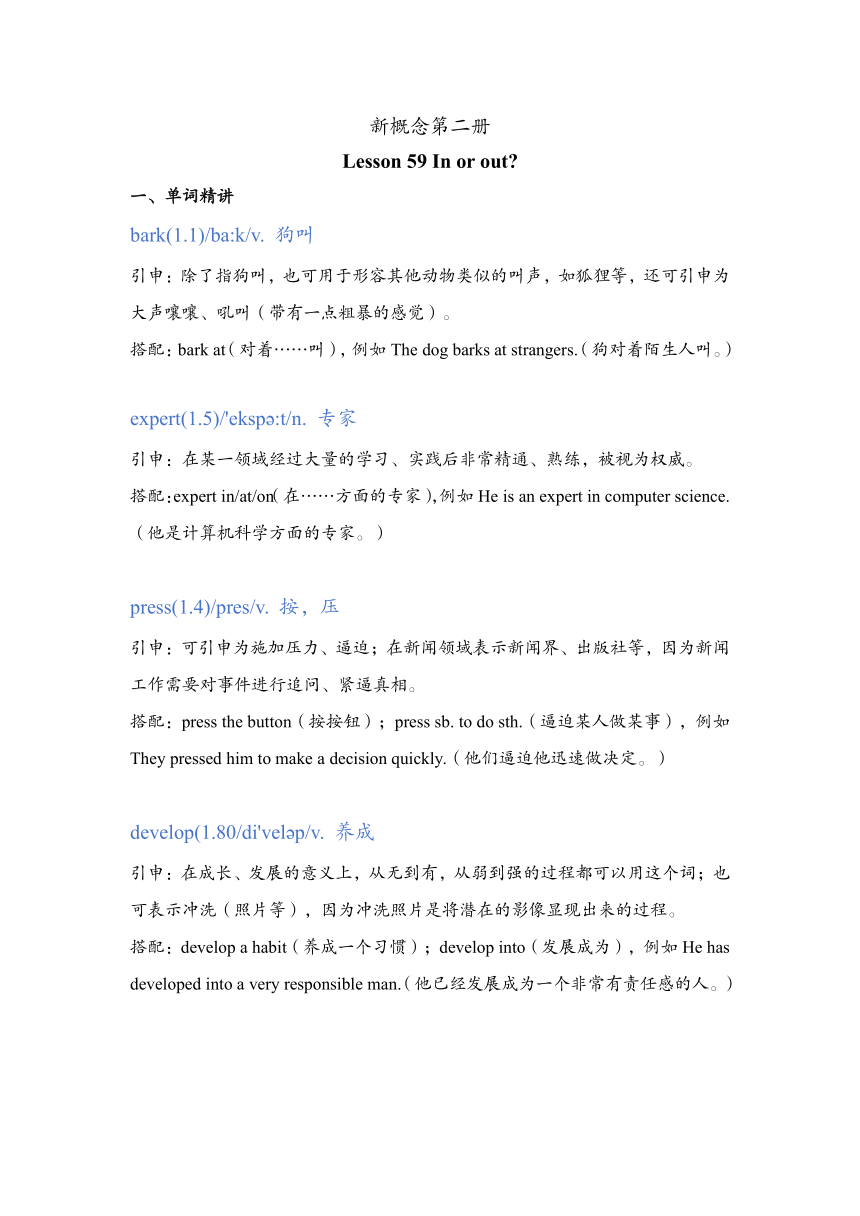
新概念第二册 Lesson 59 In or out 单词精讲 bark(1.1)/ba:k/v. 狗叫 引申:除了指狗叫,也可用于形容其他动物类似的叫声,如狐狸等,还可引申为大声嚷嚷、吼叫(带有一点粗暴的感觉)。 搭配:bark at(对着……叫),例如The dog barks at strangers.(狗对着陌生人叫。) expert(1.5)/'eksp :t/n. 专家 引申:在某一领域经过大量的学习、实践后非常精通、熟练,被视为权威。 搭配:expert in/at/on(在……方面的专家),例如He is an expert in computer science.(他是计算机科学方面的专家。) press(1.4)/pres/v. 按,压 引申:可引申为施加压力、逼迫;在新闻领域表示新闻界、-出卷网-等,因为新闻工作需要对事件进行追问、紧逼真相。 搭配:press the button(按按钮);press sb. to do sth.(逼迫某人做某事),例如They pressed him to make a decision quickly.(他们逼迫他迅速做决定。) develop(1.80/di'vel p/v. 养成 引申:在成长、发展的意义上,从无到有,从弱到强的过程都可以用这个词;也可表示冲洗(照片等),因为冲洗照片是将潜在的影像显现出来的过程。 搭配:develop a habit(养成一个习惯);develop into(发展成为),例如He has developed into a very responsible man.(他已经发展成为一个非常有责任感的人。) paw(1.4)/p :/n. 脚爪 引申:可引申为用爪子抓、扒等动作。 搭配:paw at(用爪子抓),例如The cat pawed at the ball.(猫用爪子抓球。) habit(1.8)/'h bit/n. 习惯 引申:一种经常性的行为模式或者思维方式。 搭配:get into the habit of(养成……的习惯);break a habit(打破一个习惯),例如She gets into the habit of reading before going to bed.(她养成了睡前阅读的习惯。) latch(1.4)/l t /n. 门闩 引申:可引申为理解、明白(抓住要点的感觉),不过这种用法比较少见。 搭配:latch onto(理解;缠住),例如He latched onto the main idea quickly.(他很快就理解了主要思想。) remove(1.11)/ri'mu:v/v.拆掉,取下 引申:除了物理上的拆掉、取下,还可表示去除(抽象的东西,如污渍、困难等),也有免职、开除(从职位上移走某人)的意思。 搭配:remove from(从……移除),例如Please remove the book from the shelf.(请把书从书架上拿下来。) 重点句型 To,In order to,So as to,So that,In order that表达目的几种方式 带to的不定式及in order to和so as to可以用来表示目的: I went to live in France to/in order to/so as to learn French. not to可以用来表示取舍: I went to France not to study French, but to study chemics. so as not to/in order not to可以用于表示“以防”: I shut the door quietly, so as not to/in order not to wake the bady. 在bring,buy,need,take,use,want等动词后经常用宾语加to不定式,用来表示宾语的目的。 I need a spoon to eat this ice cream with. 连词so that,in order that可以引导目的状语从句。目的状语从句必须具备一个特征, 在动词前面一定要出现情态动词,当主句用一般现在时、现在完成时或一般将来时的时候,so that和in order that后面可以跟may,can或will;当主句用一般过去时、过去进行时或过去完成时的时候,so that和in order that后面可以跟should,could,might或would。 I’ve arrived early so that/ in order that I may/ can /will get the tickets. I arrived early so that/in order that I might not miss anything. 当前后主语不一致时,不定式前面加for +名词/代词比that结构更简洁,不定式的逻辑主语for sb. to do sth. He was barking for someone to let him ... ...
~~ 您好,已阅读到文档的结尾了 ~~